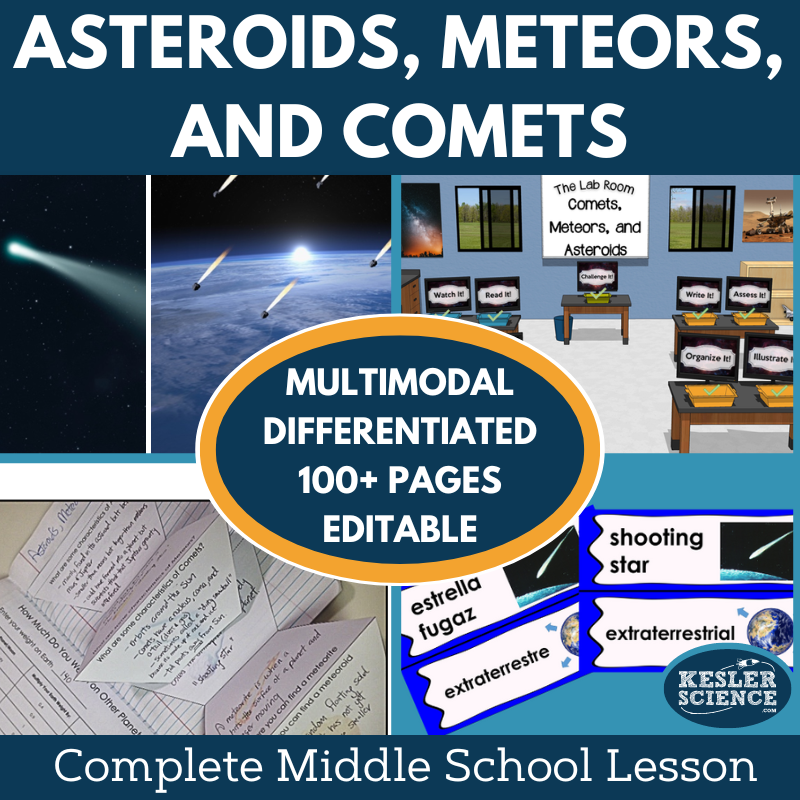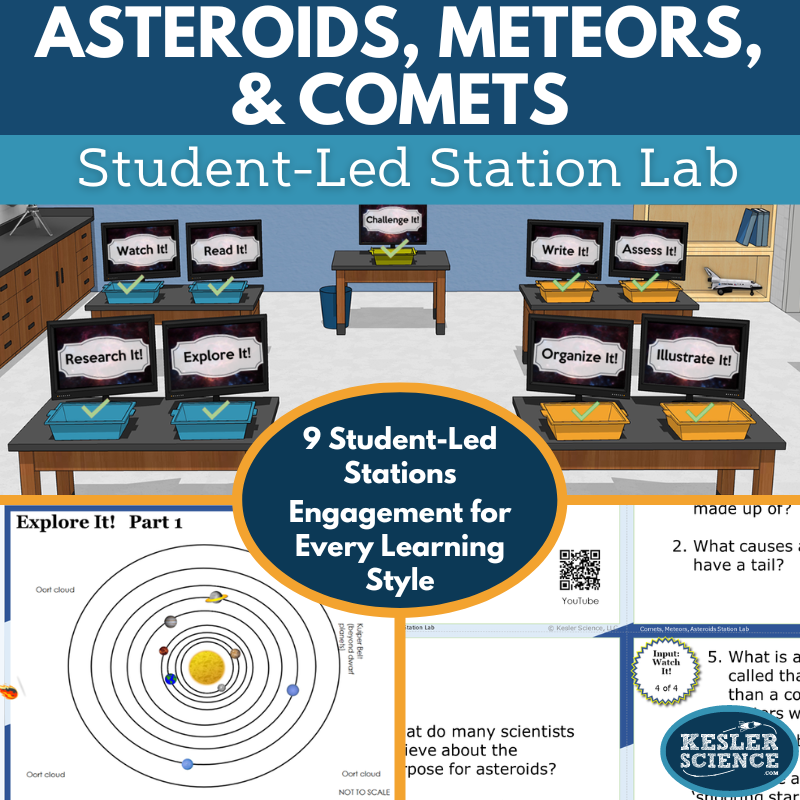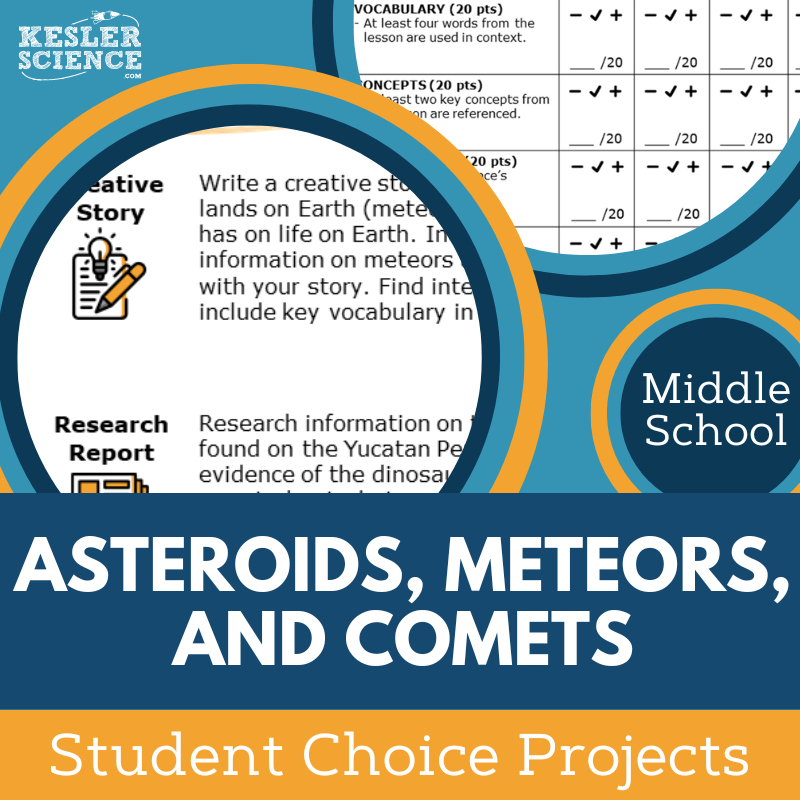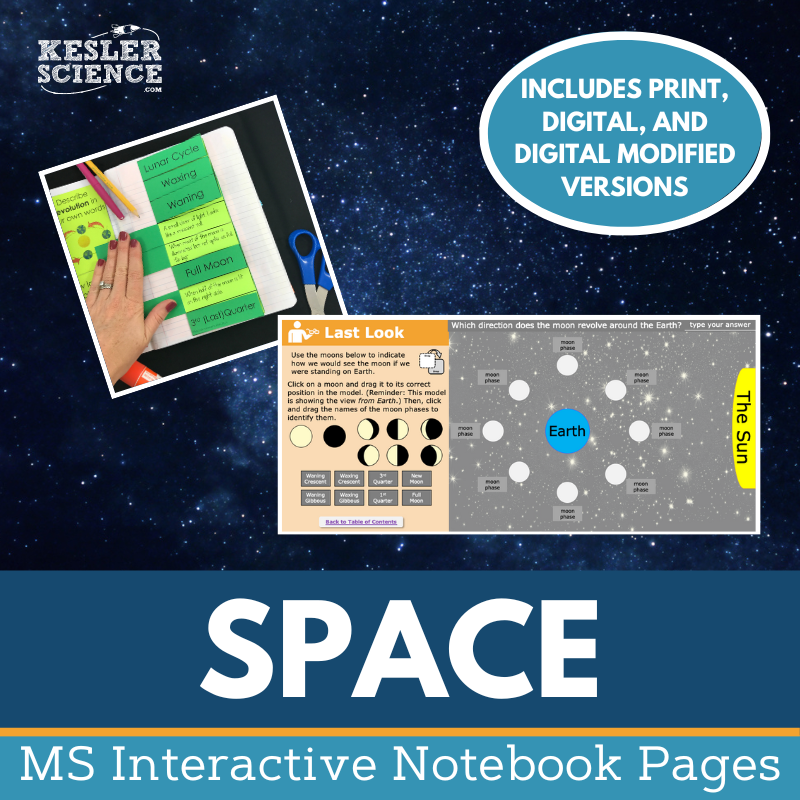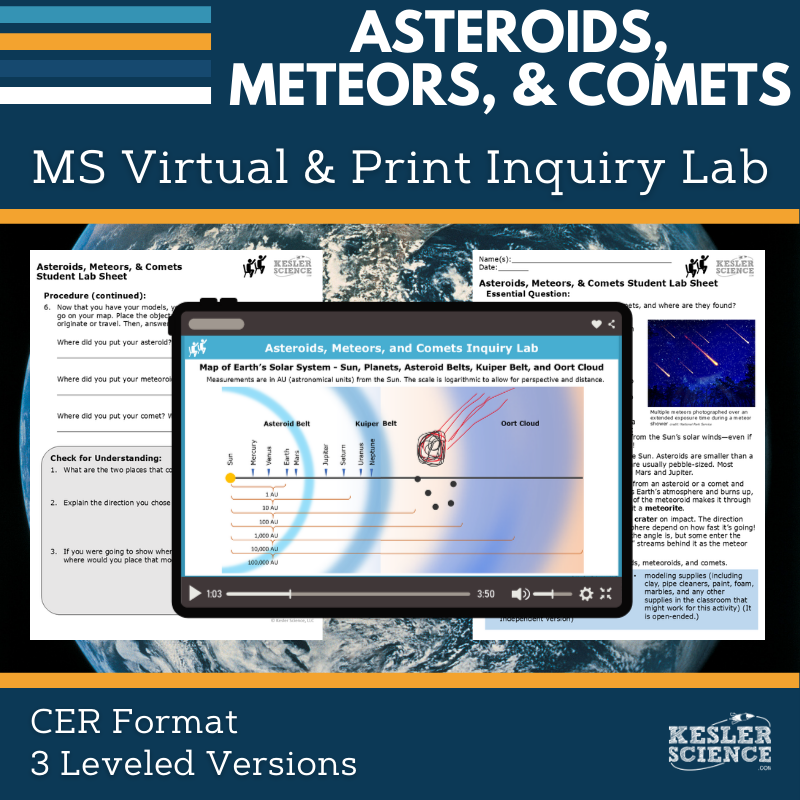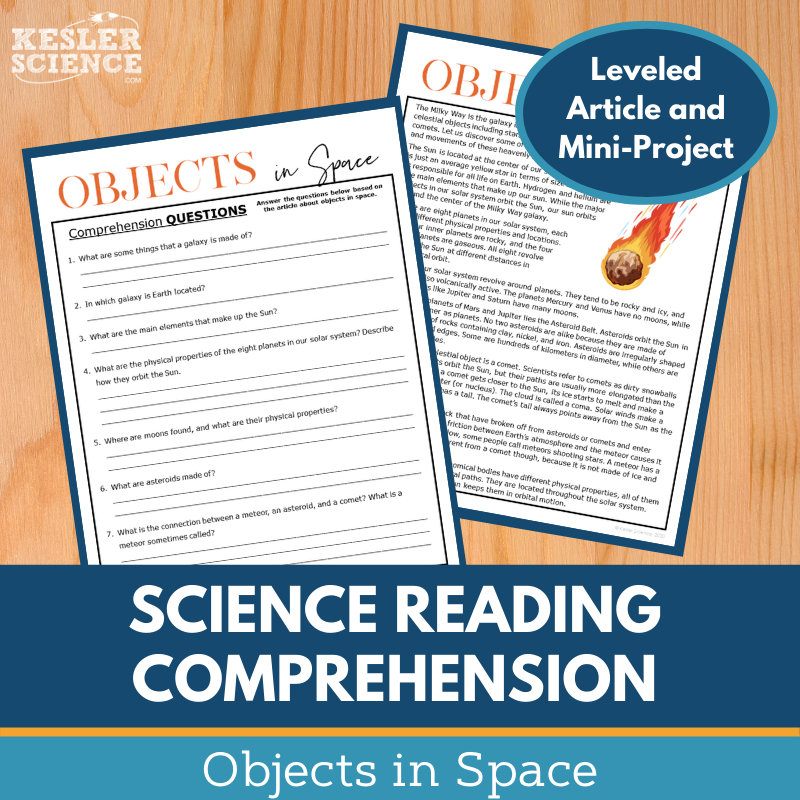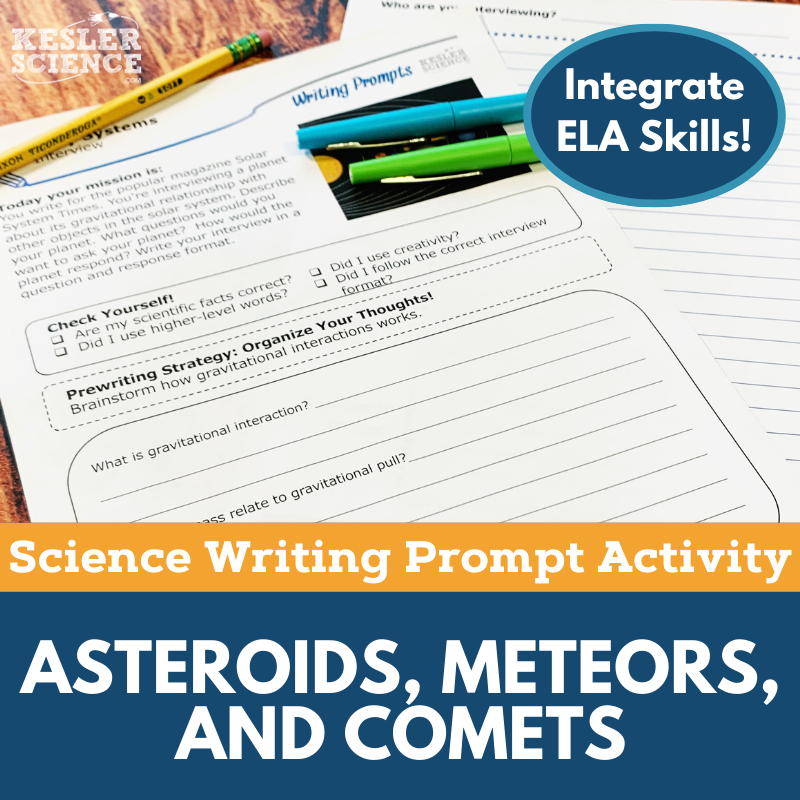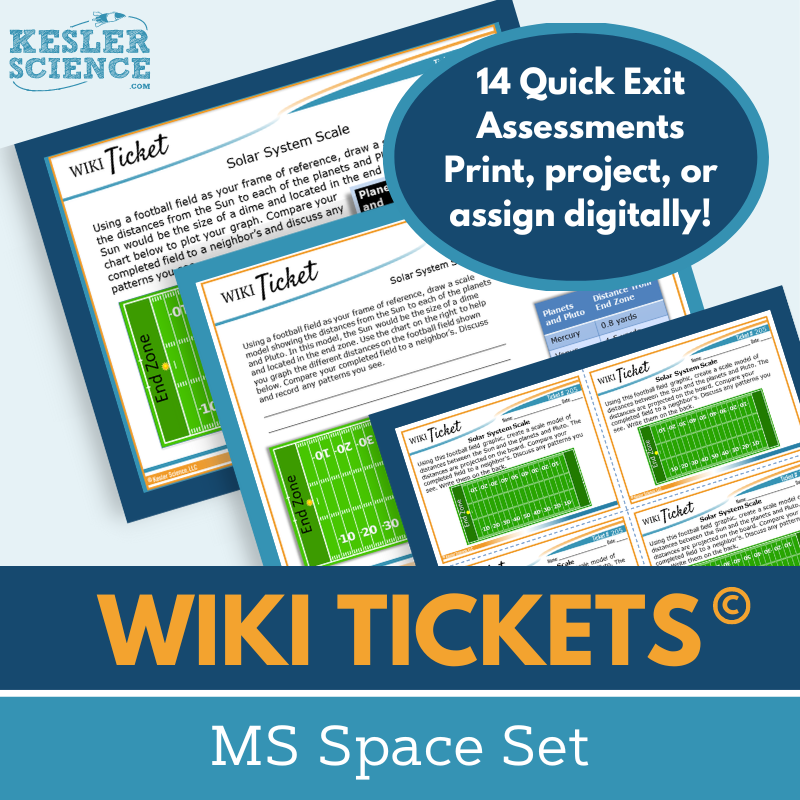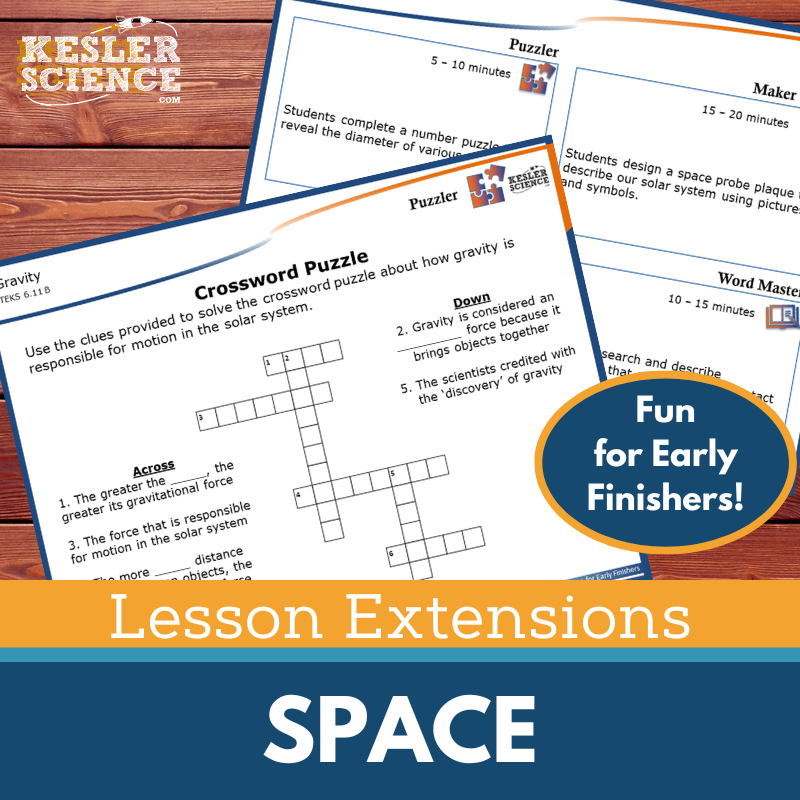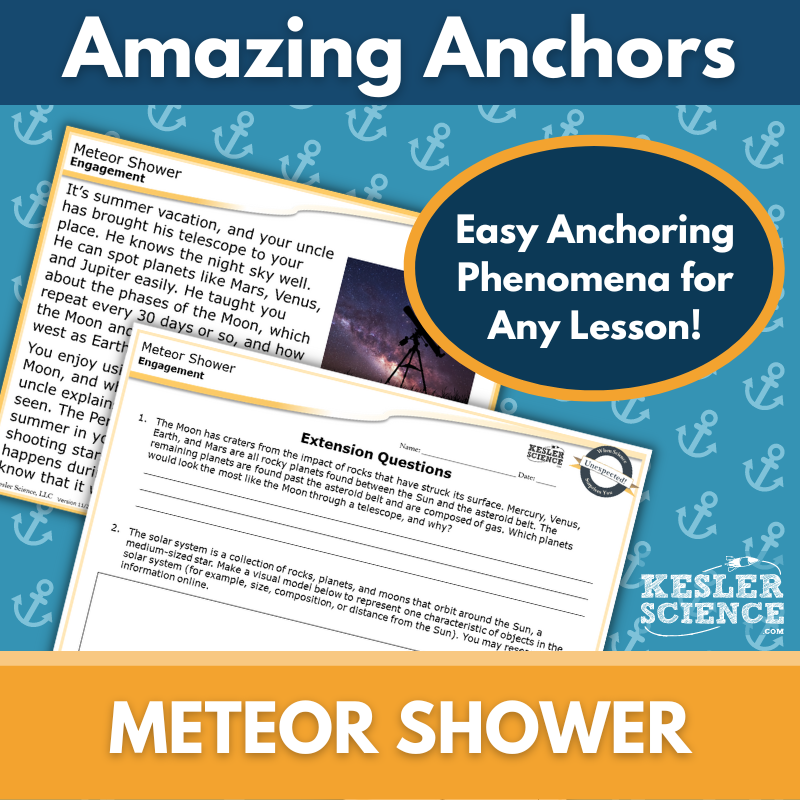Asteroids, Meteors, and Comets Activities for Middle School Science
Kesler Science Asteroids, Meteors, and Comets resources offer a comprehensive, engaging lesson plan for middle school students. The resources below will give students a comprehensive understanding of asteroids, meteors, and comets. All of the following materials are also included in the Kesler Science Membership.
The Kesler Science complete 5E lesson on asteroids, meteors, and comets provides all the materials you need to teach a multi-day, engaging science lesson with minimal prep. Perfect for 6th-8th grade students, it covers essential questions about the physical properties, locations, and movements of these space objects. The lesson is designed to be flexible and multimodal, offering both printable and digital options for classroom or virtual learning, and includes differentiated materials to support all learners.
The lesson follows the 5E model: Engagement, Exploration, Explanation, Elaboration, and Evaluation. During the Exploration phase, students participate in a student-led station lab with nine differentiated stations, including activities like hands-on demos, reading, research, video analysis, and writing. Output stations allow students to show their understanding through organizing, illustrating, and answering questions. Early finishers can challenge themselves with additional activities.
In the Explanation phase, students use editable PowerPoints, interactive notebooks (available in both English and Spanish), and note-taking templates to reinforce their learning. The Elaboration phase includes student-choice projects for further extension, while the Evaluation section offers standards-aligned assessment questions. This comprehensive lesson ensures that students gain a deep understanding of space science while offering teachers flexibility in lesson delivery.
The Kesler Science complete 5E lesson on asteroids, meteors, and comets provides all the materials you need to teach a multi-day, engaging science lesson with minimal prep. Perfect for 6th-8th grade students, it covers essential questions about the physical properties, locations, and movements of these space objects. The lesson is designed to be flexible and multimodal, offering both printable and digital options for classroom or virtual learning, and includes differentiated materials to support all learners.
The lesson follows the 5E model: Engagement, Exploration, Explanation, Elaboration, and Evaluation. During the Exploration phase, students participate in a student-led station lab with nine differentiated stations, including activities like hands-on demos, reading, research, video analysis, and writing. Output stations allow students to show their understanding through organizing, illustrating, and answering questions. Early finishers can challenge themselves with additional activities.
In the Explanation phase, students use editable PowerPoints, interactive notebooks (available in both English and Spanish), and note-taking templates to reinforce their learning. The Elaboration phase includes student-choice projects for further extension, while the Evaluation section offers standards-aligned assessment questions. This comprehensive lesson ensures that students gain a deep understanding of space science while offering teachers flexibility in lesson delivery.
The Kesler Science Asteroids, Meteors, and Comets Station Lab offers a modular, student-led approach to learning about space science. This activity keeps middle school students engaged as they explore the physical properties, location, and movements of these objects in space. With differentiated stations, students can learn independently or in small groups, and each station includes task cards, signage, and resources to guide them through their exploration.
This activity includes eight input stations, such as “Explore It!” and “Research It!,” where students encounter new concepts through hands-on activities, reading, videos, and web research. It also provides four output stations where students demonstrate their knowledge through writing, illustrating, and organizing their understanding of asteroids, meteors, and comets. A bonus “Challenge It!” station is included for early finishers or advanced learners.
The station lab is designed to be flexible and can be used in both traditional classrooms and virtual learning environments. It comes with all necessary materials, including literature, task cards, and access to digital tools for remote learning. Teachers can easily implement this resource with minimal preparation, making it an efficient way to engage students in space science while saving time.
The Kesler Science Asteroids, Meteors, and Comets Station Lab offers a modular, student-led approach to learning about space science. This activity keeps middle school students engaged as they explore the physical properties, location, and movements of these objects in space. With differentiated stations, students can learn independently or in small groups, and each station includes task cards, signage, and resources to guide them through their exploration.
This activity includes eight input stations, such as “Explore It!” and “Research It!,” where students encounter new concepts through hands-on activities, reading, videos, and web research. It also provides four output stations where students demonstrate their knowledge through writing, illustrating, and organizing their understanding of asteroids, meteors, and comets. A bonus “Challenge It!” station is included for early finishers or advanced learners.
The station lab is designed to be flexible and can be used in both traditional classrooms and virtual learning environments. It comes with all necessary materials, including literature, task cards, and access to digital tools for remote learning. Teachers can easily implement this resource with minimal preparation, making it an efficient way to engage students in space science while saving time.
The Kesler Science Asteroids, Comets, and Meteors Student Choice Projects empower middle school students to select a project that suits their learning style. With six different project options and the chance to “design your own,” students have the flexibility to explore the topic creatively. The included grading rubric allows for self-assessment, peer reviews, or teacher evaluations, making it adaptable for various classroom settings.
This lesson provides a variety of multimodal project choices, giving students the opportunity to demonstrate their knowledge in ways that best suit their strengths. Teachers can adjust the rubric to fit specific grading preferences and ensure all students are assessed fairly. The projects encourage independence and creativity, fostering engagement in the topic of space science.
Included in the purchase are nine project options, a teacher directions page, and editable rubrics. Differentiated versions are available to support students needing additional assistance, and the project encourages extension for those who need a challenge. Minimal supplies are needed, including basic classroom materials or digital tools, making this resource flexible for any teaching environment.
The Kesler Science Asteroids, Comets, and Meteors Student Choice Projects empower middle school students to select a project that suits their learning style. With six different project options and the chance to “design your own,” students have the flexibility to explore the topic creatively. The included grading rubric allows for self-assessment, peer reviews, or teacher evaluations, making it adaptable for various classroom settings.
This lesson provides a variety of multimodal project choices, giving students the opportunity to demonstrate their knowledge in ways that best suit their strengths. Teachers can adjust the rubric to fit specific grading preferences and ensure all students are assessed fairly. The projects encourage independence and creativity, fostering engagement in the topic of space science.
Included in the purchase are nine project options, a teacher directions page, and editable rubrics. Differentiated versions are available to support students needing additional assistance, and the project encourages extension for those who need a challenge. Minimal supplies are needed, including basic classroom materials or digital tools, making this resource flexible for any teaching environment.
The Kesler Science Space Science Interactive Notebook is an engaging resource for teachers looking to create interactive learning experiences for their students. It includes both print and digital versions, making it perfect for traditional classrooms, 1:1 environments, or distance learning.
The bundle covers key space science topics such as asteroids, meteors, and comets, the Big Bang theory, eclipses, the electromagnetic spectrum, galaxies, and more. The digital version features a PowerPoint interactive notebook, which can be uploaded to Google Slides or learning management systems like MS Teams or Canvas. Reflection pages and space for students to take notes are included, along with a teacher answer key and modified versions for students with accommodations.
The print version provides a full set of blank templates for students, pre-filled templates for those needing modifications, and color photos to illustrate how each template should be used. This bundle is designed to support differentiated learning and keep students engaged in key space science concepts.
The Kesler Science Space Science Interactive Notebook is an engaging resource for teachers looking to create interactive learning experiences for their students. It includes both print and digital versions, making it perfect for traditional classrooms, 1:1 environments, or distance learning.
The bundle covers key space science topics such as asteroids, meteors, and comets, the Big Bang theory, eclipses, the electromagnetic spectrum, galaxies, and more. The digital version features a PowerPoint interactive notebook, which can be uploaded to Google Slides or learning management systems like MS Teams or Canvas. Reflection pages and space for students to take notes are included, along with a teacher answer key and modified versions for students with accommodations.
The print version provides a full set of blank templates for students, pre-filled templates for those needing modifications, and color photos to illustrate how each template should be used. This bundle is designed to support differentiated learning and keep students engaged in key space science concepts.
The Asteroids, Meteoroids, and Comets Inquiry Lab aligns with middle school space science standards by allowing students to model and investigate the differences among these celestial objects. Students will create and demonstrate the location of asteroids, meteoroids, and comets within our solar system using a variety of modeling supplies. This lab can be conducted digitally or through a hands-on, printable format, with both versions including comprehension checks, Claim-Evidence-Reasoning (C.E.R.) prompts, and reflection questions.
The lab includes three differentiated versions—dependent, modified, and independent—to support a range of learning needs. The dependent version offers guided procedures and inquiry questions, the modified version provides structured instructions and scaffolds like sentence stems or multiple-choice options, and the independent version encourages student-led exploration and decision-making. Teachers may wish to let students preview the materials to support planning and creativity.
Materials for the hands-on lab include a map of the solar system, modeling supplies, and adhesives. The digital version requires no materials and is fully interactive, making it ideal for absent students or classrooms without supplies. Editable formats, teacher resources, and answer keys are all included to streamline preparation and facilitate differentiated instruction.
The Asteroids, Meteoroids, and Comets Inquiry Lab aligns with middle school space science standards by allowing students to model and investigate the differences among these celestial objects. Students will create and demonstrate the location of asteroids, meteoroids, and comets within our solar system using a variety of modeling supplies. This lab can be conducted digitally or through a hands-on, printable format, with both versions including comprehension checks, Claim-Evidence-Reasoning (C.E.R.) prompts, and reflection questions.
The lab includes three differentiated versions—dependent, modified, and independent—to support a range of learning needs. The dependent version offers guided procedures and inquiry questions, the modified version provides structured instructions and scaffolds like sentence stems or multiple-choice options, and the independent version encourages student-led exploration and decision-making. Teachers may wish to let students preview the materials to support planning and creativity.
Materials for the hands-on lab include a map of the solar system, modeling supplies, and adhesives. The digital version requires no materials and is fully interactive, making it ideal for absent students or classrooms without supplies. Editable formats, teacher resources, and answer keys are all included to streamline preparation and facilitate differentiated instruction.
In this engaging reading comprehension lesson, students explore astronomical bodies by reading a nonfiction article focused on their physical properties, locations, and movements. After reading, students answer comprehension questions, conduct research on the Hubble Telescope, and create a visually informative infographic based on their findings.
The resource is designed for middle school students in grades 6–8, with leveled articles ranging from Lexile 1100–1300. Each passage includes 5–7 comprehension questions, a hands-on mini-project, and an optional Cornell notes template to support learning. The colorful graphics enhance student engagement but are also printer-friendly in grayscale.
Ideal for classroom use, sub plans, or virtual learning, this resource is compatible with platforms like Google Classroom, MS Teams, Schoology, and Canvas. Students can respond directly in editable slides, making it easy to assign and collect work. The lesson promotes science literacy, supports textual analysis, and encourages rich classroom discussions.
In this engaging reading comprehension lesson, students explore astronomical bodies by reading a nonfiction article focused on their physical properties, locations, and movements. After reading, students answer comprehension questions, conduct research on the Hubble Telescope, and create a visually informative infographic based on their findings.
The resource is designed for middle school students in grades 6–8, with leveled articles ranging from Lexile 1100–1300. Each passage includes 5–7 comprehension questions, a hands-on mini-project, and an optional Cornell notes template to support learning. The colorful graphics enhance student engagement but are also printer-friendly in grayscale.
Ideal for classroom use, sub plans, or virtual learning, this resource is compatible with platforms like Google Classroom, MS Teams, Schoology, and Canvas. Students can respond directly in editable slides, making it easy to assign and collect work. The lesson promotes science literacy, supports textual analysis, and encourages rich classroom discussions.
The Kesler Science Asteroids, Meteors, and Comets Science Writing Prompt Activity engages middle school students by allowing them to explore their knowledge through letter writing. This creative format helps students test their understanding of earth science while encouraging them to extend their reasoning and exploration. Designed for both in-person and virtual learning environments, the activity ensures students remain engaged outside the classroom.
Standards-aligned, this writing prompt encourages students to describe the physical properties, locations, and movements of asteroids, meteors, and comets. The low-prep, student-centered activity works as an elaboration or review, making it perfect for various classroom settings and supports a range of learning needs.
Included in the purchase are teacher directions, answer guides, rubrics, and both full- and half-sized handouts. Digital options, such as the interactive PowerPoint version, offer flexibility for in-person or remote learners. These materials can also be used for extra credit, differentiation exercises, or as a pre-test formative assessment.
The Kesler Science Asteroids, Meteors, and Comets Science Writing Prompt Activity engages middle school students by allowing them to explore their knowledge through letter writing. This creative format helps students test their understanding of earth science while encouraging them to extend their reasoning and exploration. Designed for both in-person and virtual learning environments, the activity ensures students remain engaged outside the classroom.
Standards-aligned, this writing prompt encourages students to describe the physical properties, locations, and movements of asteroids, meteors, and comets. The low-prep, student-centered activity works as an elaboration or review, making it perfect for various classroom settings and supports a range of learning needs.
Included in the purchase are teacher directions, answer guides, rubrics, and both full- and half-sized handouts. Digital options, such as the interactive PowerPoint version, offer flexibility for in-person or remote learners. These materials can also be used for extra credit, differentiation exercises, or as a pre-test formative assessment.
The Kesler Science Space WIKI Tickets are engaging formative assessments designed for 6th-8th grade science topics, offering multiple flexible formats to check student understanding. Each topic in the Space Set includes five versions: full-screen display, three handout sizes (full, split, and quarter-page), and a digital interactive option that can be used as an editable PowerPoint or Google Slides file.
These assessments are aligned with NGSS and TEKS middle school science standards, with some topics featuring multiple tickets. Each set also includes a bonus table of contents file to show standard alignment, ensuring a comprehensive understanding of the covered topics.
Perfect for both in-class and remote learning, WIKI Tickets can be used as exit tickets, bellringers, or anytime you need to gauge students' progress. Whether projected on a screen or completed digitally, these colorful and engaging assessments provide valuable insight into student comprehension of key space science topics such as the lunar cycle, solar system properties, and space exploration.
The Kesler Science Space WIKI Tickets are engaging formative assessments designed for 6th-8th grade science topics, offering multiple flexible formats to check student understanding. Each topic in the Space Set includes five versions: full-screen display, three handout sizes (full, split, and quarter-page), and a digital interactive option that can be used as an editable PowerPoint or Google Slides file.
These assessments are aligned with NGSS and TEKS middle school science standards, with some topics featuring multiple tickets. Each set also includes a bonus table of contents file to show standard alignment, ensuring a comprehensive understanding of the covered topics.
Perfect for both in-class and remote learning, WIKI Tickets can be used as exit tickets, bellringers, or anytime you need to gauge students' progress. Whether projected on a screen or completed digitally, these colorful and engaging assessments provide valuable insight into student comprehension of key space science topics such as the lunar cycle, solar system properties, and space exploration.
The Kesler Science Space Lesson Extensions provide engaging activities designed to challenge fast finishers and deepen student learning. These critical thinking tasks are connected to NGSS and TEKS space standards, offering rigorous but fun opportunities to explore topics in greater depth. With activities like puzzles, hands-on maker space tasks, tech connections, and creative word writing, these extensions promote STEAM skills and digital literacy.
The Lesson Extensions are structured to provide flexible support for teachers, with clear directions, answer keys, and both digital and paper versions. These materials help reinforce the lesson’s core concepts while offering ways to engage students during testing or other gaps in the schedule.
Perfect for independent learners, these activities push students to apply their knowledge creatively while connecting it to real-world applications. The extensions cover a variety of space science topics, including gravity, space travel, and the lunar cycle, providing additional challenges that extend the learning experience beyond the standard lesson.
The Kesler Science Space Lesson Extensions provide engaging activities designed to challenge fast finishers and deepen student learning. These critical thinking tasks are connected to NGSS and TEKS space standards, offering rigorous but fun opportunities to explore topics in greater depth. With activities like puzzles, hands-on maker space tasks, tech connections, and creative word writing, these extensions promote STEAM skills and digital literacy.
The Lesson Extensions are structured to provide flexible support for teachers, with clear directions, answer keys, and both digital and paper versions. These materials help reinforce the lesson’s core concepts while offering ways to engage students during testing or other gaps in the schedule.
Perfect for independent learners, these activities push students to apply their knowledge creatively while connecting it to real-world applications. The extensions cover a variety of space science topics, including gravity, space travel, and the lunar cycle, providing additional challenges that extend the learning experience beyond the standard lesson.
This Amazing Anchors Phenomenon Lesson introduces and reinforces concepts related to the movement and position of objects in space through the real-world context of meteor showers. The lesson begins with an engaging introductory reading on meteor showers, accompanied by comprehension and extension questions that help activate prior knowledge and prepare students for deeper exploration.
The second reading explains the science behind the movement of celestial objects and the predictability of meteor showers. It includes additional questions to reinforce learning and support student understanding of the content. A modified version is also included, offering differentiated language and sentence starters to assist diverse learners.
This TEKS-aligned, no-prep resource includes teacher directions, answer keys, and both print and digital formats suitable for interactive notebooks and LMS platforms. With projection slides and editable handouts, this lesson is designed to supplement your core instruction by anchoring the Engagement and Elaborate phases of a 5E science lesson.
This Amazing Anchors Phenomenon Lesson introduces and reinforces concepts related to the movement and position of objects in space through the real-world context of meteor showers. The lesson begins with an engaging introductory reading on meteor showers, accompanied by comprehension and extension questions that help activate prior knowledge and prepare students for deeper exploration.
The second reading explains the science behind the movement of celestial objects and the predictability of meteor showers. It includes additional questions to reinforce learning and support student understanding of the content. A modified version is also included, offering differentiated language and sentence starters to assist diverse learners.
This TEKS-aligned, no-prep resource includes teacher directions, answer keys, and both print and digital formats suitable for interactive notebooks and LMS platforms. With projection slides and editable handouts, this lesson is designed to supplement your core instruction by anchoring the Engagement and Elaborate phases of a 5E science lesson.
Year-Round Resources
These year-round activities will increase your students' understanding of many middle school science topics. All of these activities are also included in the Kesler Science Membership.
Visual Data & Graphing
You're not alone if your students struggle with understanding graphs, charts, and tables. It's a skill that takes an enormous amount of practice. This resource will help students build a strong foundation in analyzing data and creating their own data visualizations.
Bell Ringers and Warm-Ups
These middle school science bell ringers are an excellent way to engage your students as soon as they walk into your classroom. This comprehensive FULL YEAR resource includes everything you need to start off each science class with an interesting warm-up activity.
Review Board Games
Each game board has been carefully designed to keep students engaged. There are 10 different action spaces on each board and dozens of question cards. All of the actions are related to science concepts and keep the students motivated throughout the game.
Each game is ready to play. Simply print out the board and the cards and let the students enjoy reviewing nine different units.
Essential Questions
Below are the essential questions associated with the lessons and activities included in this unit. This topic is only one of more than 100 middle school science topics included in the Kesler Science Membership.
-
What are the physical properties of asteroids, meteors, and comets?
-
Where are they located?
-
How do they move about in our solar system?
Kesler Science Membership
Imagine never having to search for another middle school science lesson again. The membership gives you access to ALL of the Kesler Science products in one place (Yes, including everything above).
Say goodbye to long hours of lesson prep.

